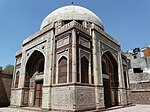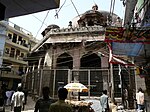Sunder Nursery

Sunder Nursery, formerly called Azim Bagh or Bagh-e-Azeem, is a 16th-century heritage park complex adjacent to the Humayun's Tomb, a UNESCO World Heritage Site in Delhi. Originally known as Azim Bagh and built by the Mughals in the 16th century, it lies on the Mughal-era Grand Trunk Road, and is spread over 90 acres (36 hectare). Future plans aim to link nearby areas to develop it into India's largest park covering 900 acres.Today Sunder Nursery contains fifteen heritage monuments of which 6 are UNESCO World Heritage Sites, including Archaeological Survey of India (ASI) protected Sundarwala Burj, Sundarwala Mahal and Lakkarwala Burj.After renovations starting in 2007, the nursery reopened to public as a heritage park on 21 February 2018. Now it contains over 300 types of trees, making it Delhi's first arboretum.During the British rule, the nursery was established to grow experimental plants, it also has a lake. which gave it its current designation as a nursery. The "Sunder" part of the name comes from the Sunder Burj tomb located in the same premises. Although the name Sunder Nursery has still held, the park has been quoted to be a 'Delhi's Central Park' after renovations (though not to be confused with the central park in Connaught Place, New Delhi).
Excerpt from the Wikipedia article Sunder Nursery (License: CC BY-SA 3.0, Authors, Images).Sunder Nursery
Humayun's Tomb Parking,
Geographical coordinates (GPS) Address Nearby Places Show on map
Geographical coordinates (GPS)
| Latitude | Longitude |
|---|---|
| N 28.596874 ° | E 77.245339 ° |
Address
Sunderwala Burj
Humayun's Tomb Parking
110013
Delhi, India
Open on Google Maps









